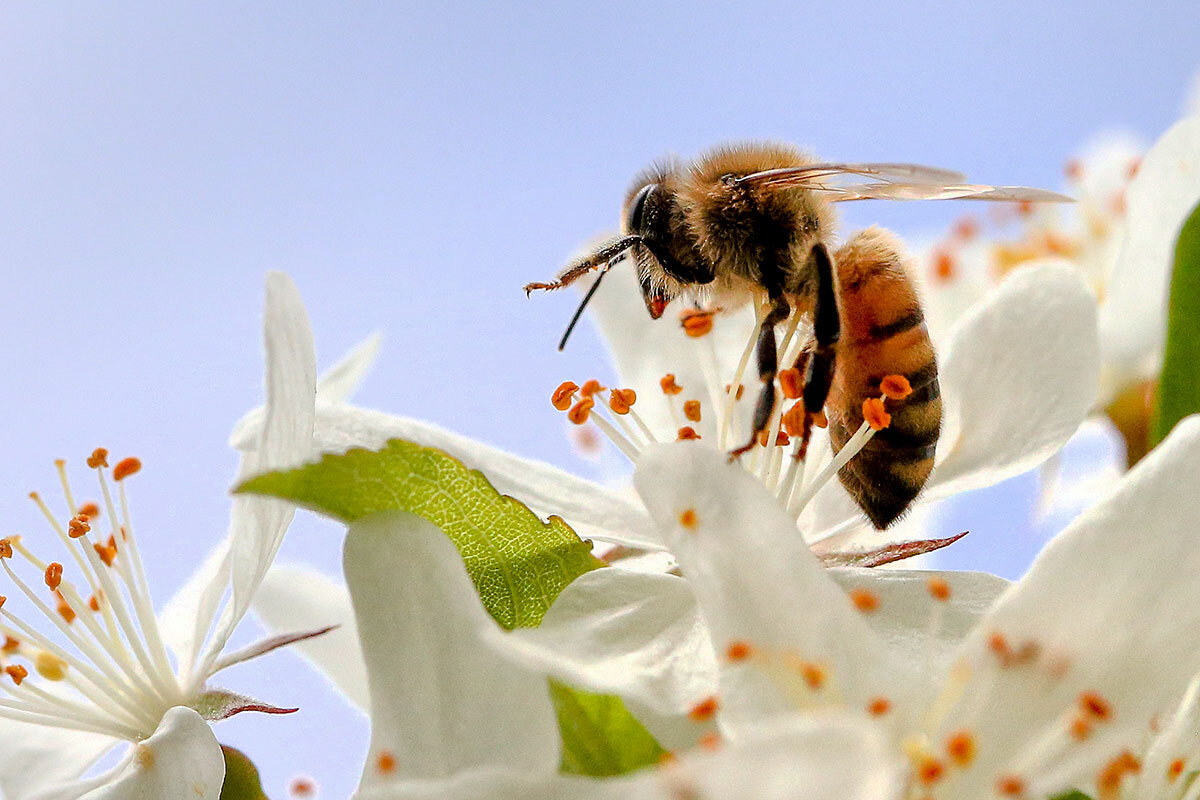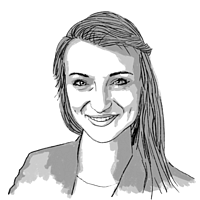Have you heard the buzz? Honeybees can count.
Loading...
What’s the first image that comes to mind when you think of mathematics? Perhaps it’s formulas scribbled on a chalkboard. Or maybe architectural drawings. Or rocket trajectories. Or taxes. Regardless, there is likely a human hand behind it.
But researchers say that humans might not be the only number crunchers in the animal kingdom. Honeybees may also be able to add and subtract, according to published Wednesday in the journal Science Advances.
And it’s not the first study to find evidence that nonhuman animals have minds for numbers.�� search for prey items stolen from their webs, suggesting that they keep running tallies.��Some seem to keep a head count of their friends. And (and monkeys) can rank quantities from smallest to largest.
Why We Wrote This
Math is often considered a uniquely human construct. But new evidence that bees can calculate simple addition and subtraction is pushing thinking about abstract thought.
Scientists say pinning down the distinction between humans’ and other animals’ numerical abilities may help us better understand ourselves, and how our species came to rule the world.
“Often when we look at animals and their intelligence, it gives us big insights into how we understand ourselves and the world we live in,” says Adrian Dyer, a study author and an associate professor at RMIT University in Melbourne, Australia.��
There is some controversy over animal arithmetic discoveries. Do they actually understand numbers like we do? Or is it more of an ability to understand relative quantities? Sorting out these questions could help scientists figure out just how special human mathematics can be.
The new bee study falls right in that controversial sweet spot. Study authors termed what the bees did addition and subtraction. But some scientists say that calling it mathematics may be overinterpreting the results.
In the experiment, the Apis mellifera bees were placed in a Y-shaped maze. Upon entering the stem of the Y, the bees encountered a set of either blue or yellow shapes. Blue indicated the problem would require the bees to add one shape, yellow to subtract one. When they approached the fork in the Y, the bees then had to choose between two more sets of shapes. The correct choice was either one less or one more than the original display, depending on the color. The incorrect choice could be any other quantity from 1 to 5.
Nearly 7 times out of 10, the bees chose correctly. The results suggest the bees were doing more than simply identifying which was “more” or “less,” says Professor Dyer, as both options could be greater than the original display for addition problems (vice versa for subtraction) and they’d still pick the correct answer.
What even is math?
But Rafael Núñez, director of the Embodied Cognition Laboratory at the University of California San Diego, says that this doesn’t necessarily indicate that the bees can comprehend numbers. Rather, he says, it shows that they are capable of discriminating between quantities.
It’s an issue of exactness, he says. He suspects the bees are using what he calls “quantical cognition” rather than numerical. The difference, he says, is similar to the difference between the words like “couple,” “few,” “several,” and “one,” “two,” “three,” “four,” “five.”
Another way to put it is that the bees are using approximate numbers, says Elizabeth Brannon, who studies comparative cognition in monkeys and both adult and child humans at the University of Pennsylvania in Philadelphia. And, she says, that’s part of what scientists think is one of the biggest distinctions between nonhuman animals’ relationship to numbers and humans’.
“The main hallmark of numerical discrimination in animals,” Professor Brannon says, has to do with ratios. “When animals are comparing two numerical values, they’re much better if they differ by a large ratio than if they differ by a very small ratio.”
Brannon herself trained monkeys to do addition and subtraction, with a similar method to the bee study. And she found that the monkeys could get the correct answer only if the ratio between the two choices was significant enough. For example, she explains, the monkeys could get the correct answer to 17 minus 7 if the choices were 10 and 5, but not if they were 10 and 9.
It remains unclear whether that’s an issue for honeybees, but the experiment did bring into question another idea about what separates human mathematics from animals’ arithmetic.
The use of symbols to denote specific numbers and mathematical functions was once thought to be unique to humans.
But this new study suggests that honeybees might be capable of using symbols, too, as the insects were trained to respond to blue and yellow as labels for addition and subtraction.
When studying animal cognition, the training element is key, says Rosa Rugani, a postdoctoral researcher at the University of Pennsylvania.��Being capable of using symbols and naturally using them in their own wild environments are two different things.
“Animals, to survive in their natural environment, they don’t need to reach this level of abstraction,” Dr. Rugani says. They don’t need to have “+” or “-”. They just need to be able to gauge food resources, keep track of their group, navigate, and assess the threat of a pack of predators. So it may be more of an indication of an animal’s ability to learn labels, rather than a mind for math.
To separate out those two things, Rugani has studied number cognition in newborn domestic chicks. Her results have suggested they may have a concept of a and can tackle some .
So what sets humans apart?
So are we humans predispositioned to have our numerical capabilities, or is it a learned or trained behavior?
Looking to language for clues, researchers found that some hunter-gatherer languages around the world have words for numerals only up to the number five – or even fewer, says Professor Núñez of UC San Diego. These societies just haven’t had .��
This suggests that humans’ mathematical abilities have been culturally developed as societies found a use for them, Núñez says. “It’s not that, because we’re humans, we [automatically] get math,” he says.
But there must be something that sets humans apart, says Jessica Cantlon, a professor at Carnegie Mellon University in Pittsburgh who co-authored the with Brannon while at Duke University. Perhaps the combined use of symbols and precision work together to enable people to process complex mathematical concepts.
Her research has compared humans with other primates, and found that the two are matched in what they can do with approximate numbers up until the humans turn 3. Then, human children hit a threshold and are better able to understand the precision of numbers.
“What lets us access that kind of thinking?” Professor Cantlon says. “I don’t know. But that’s what everybody would like to know.”
Núñez thinks it’s a matter of having a few different general capacities (which he calls “biologically evolved preconditions”) and the cultural scaffolding to put them all together.
Regardless of how it all came together, Dyer says, “I think it would be a reasonably widely accepted perspective that mathematics is a primary thing which underpins the development of technology, and is very important to the success of modern humans.”





